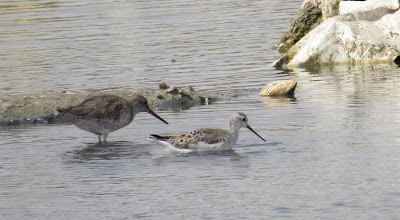As I have said before the lake is under considerable environmental pressure. One pressure is the large scale fly-tipping of household and building waste. The other main one is that the area of reeds looks set to be pumped out and replaced with landfill.
I actually wrote to Wetlands International for advice but received no reply.
Despite this pressure I discovered solid proof of local breeding of African swamphen for the first time on Sunday.
family of African swamphen
One adult African swamphen was observed with four juvenile swamphens. They were eating the reed for several minutes.
African swamphen
The colour of the bills suggests the birds are very young.
Juvenile African swamphen
This observation is well north of what had been thought was the breeding range in West Africa.
little grebe at the lake
There are young Eurasian coot there too. That species seems to have no set breeding season here as I have seen very young birds every time I have visited over a four month period.
I am less certain about the breeding times of little grebe and common moorhen. Both birds appear to keep their young better hidden.
three greenshank
After last week's discovery of a marsh sandpiper among the plentiful waders, I was on the look out for this species there again. My hopes were raised when three waders appeared but on closer inspection, they proved to be greenshank. At distance these two species can appear very similar particularly when there is no other wader near by to offer a size comparison.
yellow wagtail
Elsewhere on the site, I can report that yellow wagtail now out number white wagtail. The long standing Baillon's crake was also still present.
I had had more success with marsh sandpiper two days before at West Nouakchott pools. This salt water site provided me with a second marsh sandpiper in the space of a week having seen none all winter.
marsh sandpiper (l)
Marsh sandpiper are not common in West Africa. They breed much further east from central European Russia eastward. So it is a very westward route they have to take to winter here.
marsh sandpiper (r)
This bird gave me much better views than the previous observation.
marsh sandpiper (l)
Most Kentish plover are now in breeding plumage.
two Kentish plover
The pools are not as saline as the sea as can be shown by the presence of several wood sandpiper which don't like heavily salty water.
wood sandpiper
Actually this site is good for attracting both waders that prefer salt water and those which prefer fresher water.
grey plover
Larger waders (as well as smaller ones) such as greenshank, redshank and grey plover have been usually seen.
The final area reported here is the Riyadh district at the southern edge of the city. I went there on Saturday with Mohamed Vall. There are two main sites there. One is the water works to the east and the other is the city rubbish dump to the west of the main road.
The main news from the water works, which has about 80 metres of artificial river, is the rapid grown in the red-billed quelea population. We estimate there were over 400 present. Last time we saw about 40 and the time before none at all. We suspect this new water site is attracting them to the north of their natural range.
red-billed quelea
A booted eagle may have been interested in them but was mobbed by a pied crow and moved on.
namaqua dove
Namaqua dove may be a bird of arid open woodland but it is very attracted to water bodies. There were plenty scattered around the site.
I had hopes of seeing red-throated pipit there but these were dashed once again though both yellow wagtail and white wagtail were observed.
Waders included little ringed plover, common ringed plover, little stint and wood sandpiper.
The only larks were black-crowned sparrow lark.
The city rubbish dump in the same district was a let down once again and we decided it is scarsely worth a visit.
hoopoe lark
The only notable view was a hoopoe lark which provided a distraction display presumably to take us away from its young.
Overall though the weekend was very interesting especially taking into account the visits to the fish marker area as well as the sites in this blog.
















No comments:
Post a Comment